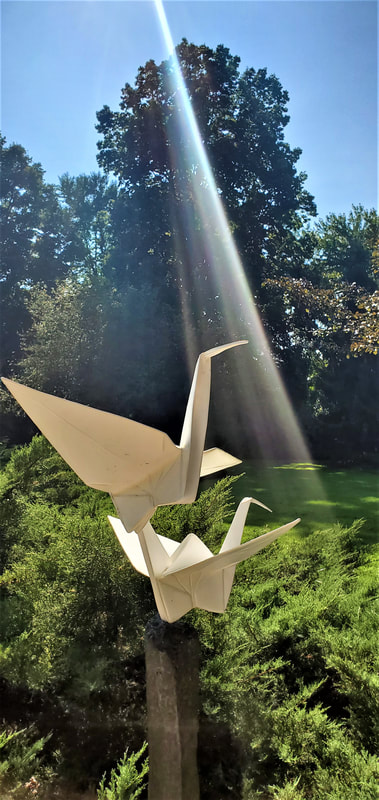Whiting Forest is part of the adjacent Dow Gardens, a botanical garden located on the former estate of Grace and Herbert Dow. Herbert Dow was founder of the Dow Chemical Company still headquartered in Midland, not far from Lake Huron. The Dows built their family home amid a sprawling property purchased in 1899. In 1936, a few years after Herbert’s death, Grace created the Herbert H. and Grace A. Dow Foundation, and eventually turned the family property over to the Foundation to be operated as a botanical garden (with no direct ties to the chemical company).
Today the 110-acre Dow Gardens boasts 35,000 annuals and 22,000 flowering bulbs laid out in geometrical patterns amid a wandering stream, ponds, and gently rolling hills. On this early autumn afternoon red Canna and Sunpatiens and yellow-petaled Brown-Eyed Susans popped brilliant against a light-blue sky.
The weekend we visited also featured a temporary outdoor metal origami sculpture exhibition by Santa Fe artists Jennifer and Kevin Box. Amid the garden’s blooming treasures were origami-like sculptures of swans, butterflies, ponies, and bison.
The 54-acre Whiting Forest became part of Dow Gardens in 1991—also by way of Dow family descendants—and was opened to the public in 2004. The forest includes a mix of planted and natural regrowth red pines, tamaracks, and assorted hardwoods on lands that were logged in the 1870s and later reforested.
Kyle Bagnall, Advanced Learning Program Manager, calls the forest “a green oasis in an urban area,” although the city of 44,000 and surrounding area boasts several additional significant green spaces and wildlife refuges as well. Whiting Forest’s bird diversity is particularly pronounced, with native woodland species mingling with migratory birds in a flyway that emanates from nearby Saginaw Bay.
In 2015, prior to Bagnall’s arrival, the Foundation commissioned the design of a handicapped-accessible canopy walk to bring visitors into the tree level and to overlook the surrounding landscape, pond, and apple orchards. Ranging from twenty-five to forty feet in the air, the ¼-mile elevated canopy walk brings visitors eye-to-beak with birds at tree-top and mid-branch levels. “Encouraging play at any age,” says Bagnall, the canopy walk also features two wooden tree pods and the rope-netted hammock for those wanting to nest for a while amid the pines.
When Bagnall came on board in 2017, he brought with him a combination of environmental education experience, birding enthusiasm, and historical awareness that perfectly suited Whiting Forest. With a college degree in Public History, he is aware of the need to preserve the legacy of the founding Dow family. His environmental education experience was honed over twenty-two years at his previous position at the nearby Chippewa Nature Center. And birding has been in his blood since he was a small child, when his father would wake him for 4 a.m. local birding expeditions. Kyle started making his own life-long birding list at age 10.
At Whiting Forest, Bagnall soon set about planning the first Birding Festival for Dow Gardens. Like everything Kyle does, the event bustled with activity. Local and regional experts led over 150 participants to enjoy activities such as bird banding at Chippewa Nature Center, viewing herons, gulls and other waterfowl at the Nayanquing Point Wildlife Area, searching for woodland migrant species at the Pine Haven Recreation Area and Albert Szok Preserve, and scouting coastal birds along Lake Huron’s Saginaw Bay. Kyle himself blended history and nature, helping birders spot migratory species in Midland County’s historic cemeteries.
Dianne and I hopped on board the two-mast Tall Ship Appledore, setting sail for Lake Huron’s Saginaw Bay, as part of yet another outdoor excursion.
Indoor sessions included presentations on raptors, wetland preservation, “birding by ear,” and creating a bird-friendly yard. Additional Festival workshops included nature writing, art, and photography.
Culminating the festival was the keynote address by David Allen Sibley, author and illustrator of the New York Times best-seller The Sibley Guide to Birds, a work that participants look upon as the premier guide to birding.
On Friday evening, nearing sunset, Dianne and I sat quietly at a table outside the Whiting Forest Café, while other festival-goers mingled nearby. Bagnall chatted with everyone. Soon his phone buzzed, a text from birders in the nearby forest who’d spotted some specimens Kyle would want to see.
We all flocked, then, to the canopy walk, where the setting sun was bringing out new voices. Forty feet above the ground, we listened to the nighthawks.
-- November 2019



